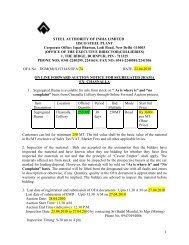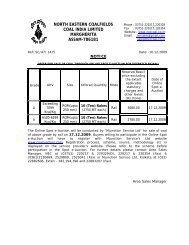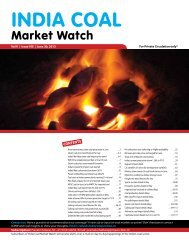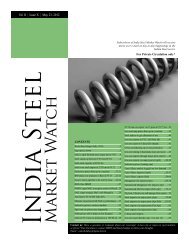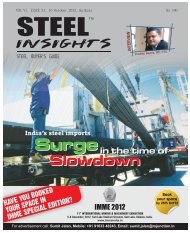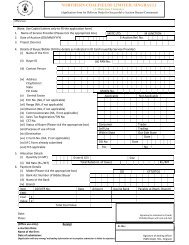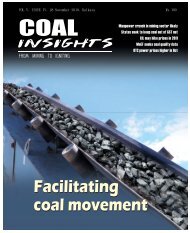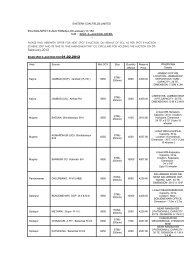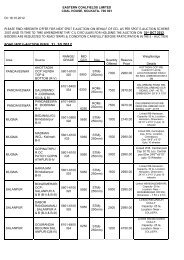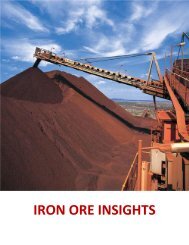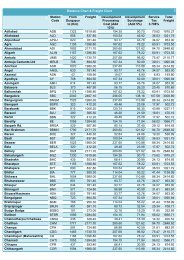India's largest coal handling agency - Mjunction
India's largest coal handling agency - Mjunction
India's largest coal handling agency - Mjunction
Create successful ePaper yourself
Turn your PDF publications into a flip-book with our unique Google optimized e-Paper software.
Logistics<br />
Freight rates improve strongly in end-Oct<br />
Sarbani Haldar<br />
Dry bulk freight rates were strongly volatile throughout<br />
September on the back of varied vessel chartering<br />
activities. Though rates improved somewhat during<br />
the beginning of the month, they later declined on the back of<br />
low chartering activity as a result of less cargo to be shipped.<br />
However, towards the end of the month, rates unexpectedly<br />
improved, mainly in the Capesize segment, due to the rising<br />
demand for iron ore from China. Over the next few weeks,<br />
the rates remained at nearly the same level with the Capesize<br />
segment witnessing very strong improvements during the<br />
initial days of October.<br />
With iron ore inventory in the country being low, it is likely<br />
that China would be importing a lot of iron ore for the fourth<br />
quarter. In the last week of October too, iron ore producer Vale<br />
secured more than 12 vessels. Around the end of the same<br />
week, the Capesize freight rates on the Australia to China<br />
route were around $11.75 to $12 per ton, while freight rates<br />
in the Brazil to China route were around $31 to $31.5 per ton.<br />
The sentiments in this region are also upbeat at the moment<br />
as several vessels continue to be fixed from Port Hedland and<br />
Dampier. As per market sources, rates in the South America<br />
to China route climbed steadily, with reports of freight rates<br />
being fixed at $34 per ton at Itaqui/Qingdao.<br />
China’s iron ore imports would continue to pull up rates in<br />
the Capesize segment in the coming days as well, as presently<br />
the iron ore stocks in the country are low and domestic rates<br />
are also high thereby making imports favourable. Besides,<br />
keeping in mind the winter season, demand for thermal<br />
<strong>coal</strong> from this region too, would improve further thereby<br />
supporting the rates.<br />
However, rates in both the Supramax and the Panamax<br />
segments have cooled down to some extent during this week.<br />
Much of the weakness in the Supramax rates was owing to less<br />
trading activity in the India to China route during this week.<br />
4500<br />
4000<br />
3500<br />
3000<br />
2500<br />
2000<br />
1500<br />
1000<br />
2-Aug 11-Aug 20-Aug 29-Aug 7-Sep 16-Sep 25-Sep 4-Oct 13-Oct 22-Oct<br />
Baltic Dry Index<br />
Baltic Supramax Index<br />
Source: Insights Research<br />
Baltic Exchange Index<br />
Baltic Capsize Index<br />
Baltic Panamax Index<br />
Tex Report data has revealed that spot freight rates in the<br />
Brazil to China route have improved since September. For<br />
transporting 1,60,000 tons of iron ore in a Capesize vessel<br />
from Tubarao, Brazil to Qingdao, China, the freight rate had<br />
been fixed at $30.60 per ton for a laycan scheduled for October<br />
30 to November 5. Earlier, in the same route, in September,<br />
for transporting the same quantity of iron ore for the same<br />
destination, the freight rate was $29.50 per ton for a laycan<br />
scheduled for October 1 to October 10.<br />
Rates in the Western Australia to China route have also<br />
behaved in the same manner. According to Tex Report data,<br />
spot rates for transporting 1,70,000 tons of iron ore from Port<br />
Hedland, Western Australia to Qingdao, China, the freight<br />
rate was $11.80 per ton for a laycan scheduled for November<br />
1 to November 10. Earlier, in the same route, for transporting<br />
the same quantity from Port Hedland, Australia to Qingdao,<br />
China, the freight rate has been fixed at $10.15 per ton for a<br />
laycan scheduled for October 6 to October 15.<br />
Although the present market conditions would be<br />
conducive for improvement in the Capesize rates, the large<br />
supply of new building vessels coming on stream during this<br />
week could be a source of weakness in rates. As per market<br />
sources, 20 new vessels have been handed over to the owners<br />
as compared to 11 vessels being sent to the scrapyard. Going<br />
by the way the dry bulk market is poised, Capesize rates could<br />
see some improvement due to the iron ore demand, provided<br />
China continues to source ore. Keeping everything in mind,<br />
rates might just continue to hover at the present levels in the<br />
coming week with a minor upward or downward correction.<br />
Earlier, towards the end of September, rates in the Capesize<br />
segment rose due to improving demand for chartering vessels<br />
ahead of the long Chinese holidays. Spot rates in the Brazil to<br />
China route were reported to be around $28 per ton. In the<br />
Western Australia to China route, the Capesize fixture rates<br />
stood at $10.81 per ton.<br />
The increasing iron ore prices also supported rates to<br />
a large extent. Besides, the rates were buoyed by growing<br />
expectations of firm demand from Chinese steel mills, which<br />
have been asked to resume production after a governmentimposed<br />
shutdown. As per available information, several<br />
mills in China’s steel production hub of Hebei province,<br />
which have been either shut down or told to cut output by as<br />
much as 70 percent as part of Beijing’s power-saving drive,<br />
have been directed to restart production.<br />
Another factor affecting rates in India, is the ban on importing<br />
of iron ore from Karnataka, which has put pressure on the supply<br />
of ore, thereby pulling up rates. Earlier in September, reports<br />
of China taking measures to shut down obsolete steel mills<br />
and other plants together with its power conservation drive,<br />
weighed down on the market sentiments, which in turn pulled<br />
COAL INSIGHTS 66 October 2010



